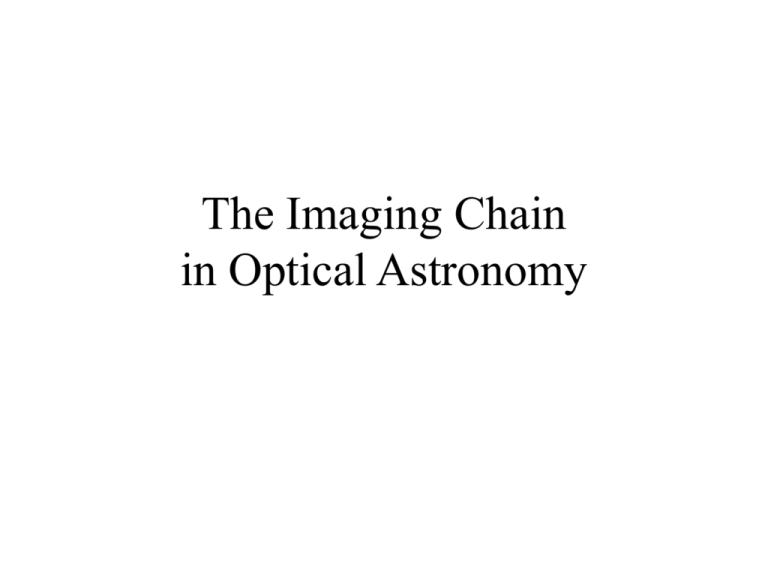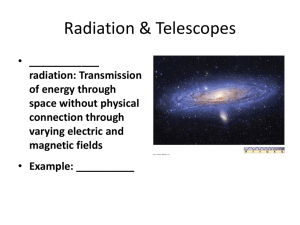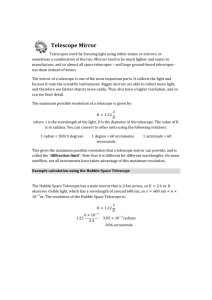The Imaging Chain for Optical Astronomy
advertisement

The Imaging Chain in Optical Astronomy Review and Overview “Imaging Chain” includes these elements: 1. 2. 3. 4. 5. 6. 7. 8. energy source object collector detector (or sensor) processor display analysis storage (if any) Optical Imaging Chain 1: source 5: processing 2: object 3: collector 4: sensor 6: display 7: analysis Source and/or Object • In astronomy, the source of energy (1) and the object (2) are almost always one and the same! • i.e., The object emits the light – Examples: • Galaxies • Stars – Exceptions: • Planets and the moon • Dust and gas that reflects or absorbs starlight Optical Imaging Chain in Astronomy 5: processing 1: source 2: object or 6: display 7: analysis 3: collector 4: sensor 8: storage Optical Imaging Chain in Radio Astronomy 1,2 3,4 radio waves receiver where waves are collected waves converted into electro signals 5 computer received as signal 6,7 Specific Requirements for Astronomical Imaging Systems • Requirements always conflict – Always want more than you can have must “trade off” desirable attributes Deciding the relative merits is a difficult task “general-purpose” instruments (cameras) may not be sufficient • Want simultaneously to have: – excellent angular resolution AND wide field of view – high sensitivity AND wide dynamic range • Dynamic range is the ability to image “bright” and “faint” sources – broad wavelength coverage AND ability to measure narrow spectral lines Angular Resolution vs. Field of View • Angular Resolution: ability to distinguish sources that are separated by small angles – Limited by: • Optical Diffraction • Sensor Resolution • Field of View: angular size of the image field – Limited by: • Optics • Sensor Size (area) Sensitivity vs. Dynamic Range • Sensitivity – ability to measure faint brightnesses • Dynamic Range – ability to image “bright” and “faint” sources in same system Wavelength Coverage vs. Spectral Resolution • Wavelength Coverage – Ability to image over a wide range of wavelengths – Limited by: • Spectral Transmission of Optics (Glass cuts off UV, far IR) • Spectral Resolution – Ability to detect and measure narrow spectral lines – Limited by: • “Spectrometer” Resolution (number of lines in diffraction grating) Optical Collector (Link #3) Optical Collection (Link #3): Refracting Telescopes • Lenses collect light • BIG disadvantages – Chromatic Aberrations (due to dispersion of glass) – Lenses are HEAVY and supported only on periphery • Limits the Lens Diameter • Largest is 40" at Yerkes Observatory, Wisconsin http://astro.uchicago.edu/vtour/40inch/kyle3.jpg Optical Collection (Link #3): Reflecting Telescopes • Mirrors collect light • Chromatic Aberrations eliminated • Fabrication techniques continue to improve • Mirrors may be supported from behind Mirrors may be made much larger than refractive lenses Optical Reflecting Telescopes • Concave parabolic primary mirror to collect light from source – modern mirrors for large telescopes are thin, lightweight & deformable, to optimize image quality 3.5 meter WIYN telescope mirror, Kitt Peak, Arizona Thin and Light (Weight) Mirrors • Light weight Easier to point – “light-duty” mechanical systems cheaper • Thin Glass Less “Thermal Mass” – Reaches Equilibrium (“cools down” to ambient temperature) quicker http://www.cmog.org/page.cfm?page=374 Hale 200" Telescope Palomar Mountain, CA http://www.astro.caltech.edu/observatories/palomar/overview.html 200" mirror (5 meters) for Hale Telescope • • • • • • • Monolith (one piece) Several feet thick 10 months to cool 7.5 years to grind Mirror weighs 20 tons Telescope weighs 400 tons “Equatorial” Mount – follows sky with one motion Keck telescopes, Mauna Kea, HI http://www2.keck.hawaii.edu/geninfo/about.html 400" mirror (10 meters) for Keck Telescope • 36 segments • 3" thick • Each segment weighs 400 kg (880 pounds) – Total weight of mirror is 14,400 kg (< 15 tons) • Telescope weighs 270 tons • “Alt-azimuth” mount (left-right, up-down motion) – follows sky with two motions + rotation Basic Designs of Optical Reflecting Telescopes 1. Prime focus: light focused by primary mirror alone 2. Newtonian: use flat, diagonal secondary mirror to deflect light out side of tube 3. Cassegrain: use convex secondary mirror to reflect light back through hole in primary 4. Nasmyth (or Coudé) focus (coudé French for “bend” or “elbow”): uses a tertiary mirror to redirect light to external instruments (e.g., a spectrograph) Prime Focus Sensor f Mirror diameter must be large to ensure that obstruction is not significant Newtonian Reflector Sensor Cassegrain Telescope Sensor Secondary Convex Mirror Feature of Cassegrain Telescope • Long Focal Length in Short Tube f Location of Equivalent Thin Lens Coudé or Nasmyth Telescope Sensor Optical Reflecting Telescopes Schematic of 10-meter Keck telescope (segmented mirror) Large Optical Telescopes Telescopes with largest diameters (in use or under construction: – 10-meter Keck (Mauna Kea, Hawaii) – 8-meter Subaru (Mauna Kea) – 8-meter Gemini (twin telescopes: Mauna Kea & Cerro Pachon, Chile) – 6.5-meter Mt. Hopkins (Arizona) – 5-meter Mt. Palomar (California) – 4-meter NOAO (Kitt Peak, AZ & Cerro Tololo, Chile) Keck telescope mirror (note person) http://seds.lpl.arizona.edu/billa/bigeyes.html Summit of Mauna Kea, with Maui in background Why Build Large Telescopes? 1. Larger Aperture Gathers MORE Light – – Light-Gathering Power Area Area of Circular Aperture = D2 / 4 D2 • D = diameter of primary collecting element 2. Larger aperture better angular resolution – recall that: D Why Build Small Telescopes? 1. Smaller aperture collects less light • less chance of saturation (“overexposure”) on bright sources 2. Smaller aperture larger field of view (generally) – Determined by “F ratio” or “F#” f F# D f = focal length of collecting element D = diameter of aperture F Ratio: F# • F# describes the ability of the optic to “deflect” or “focus” light – Smaller F# optic “deflects” light more than system with larger F# Small F# Large F# F# of Large Telescopes • Hale 200" on Palomar: f/3.3 – focal length of primary mirror is: 3.3 200" = 660" = 55' 16.8 m – Dome must be large enough to enclose • Keck 10-m on Mauna Kea: f/1.75 – focal length of primary mirror is: 1.75 10m = 17.5 m 58 m F Ratio: F# • Two reflecting telescopes with different F# and same detector have different “Fields of View”: large Small F# small Large F# Sensors (Link #4) Astronomical Cameras Usually Include: 1. Spectral Filters – – most experiments require specific wavelength range(s) broad-band or narrow-band 2. “Reimaging” Optics – enlarge or reduce image formed by primary collecting element 3. Light-Sensitive Detector: Sensor Astronomical Sensors • Most common detectors: – Human Eye – Photographic Emulsion • film • plates – Electronic Sensors • CCDs Angular Resolution • Fundamental Limit due to Diffraction in “Optical Collector” (Link #3) D • But Also Limited by Resolution of Sensor! Charge-Coupled Devices (CCDs) • Standard light detection medium for BOTH professional and amateur astronomical imaging systems – Significant decrease in price • numerous advantages over film: – high quantum efficiency (QE) • meaning most of the photons incident on CCD are “counted” – linear response • measured signal is proportional to number of photons collected – fast processing turnaround (CCD readout speeds ~1 sec) • NO development of emulsion! – regular grid of sensor elements (pixels) • as opposed to random distribution of AgX grains – image delivered in computer-ready form CCD Basics • Light-sensitive electronic element based on crystalline silicon – crystal = “lattice” of atoms at regular spacings – acts as though electrons have two states: • “bound” to atom • “free” to roam through lattice CCD Basics • Incident photon adds energy to electron to “kick” it up into the “free” states – energy of photon must be sufficiently large for electron to “reach” the free states – to be absorbed, the photon wavelength must be less than maximum max 1100 nm (near infrared) Energy Electrons in “Free” States (“conduction band”) Electrons in “Bound” States (“valance band”) photon CCD Basics • Silicon structure is divided into pixels – e- transferred and “counted” one pixel at a time http://www.byte.com/art/9510/img/505099d2.htm Sensor Resolution • Obvious for Electronic Sensors (e.g., CCDs) • Elements have finite size • Light is summed over area of sensor element (“integrated”) • Light from two stars that falls on same element is added together • stars cannot be distinguished in image! x Same Effect in Photographic Emulsions • More difficult to quantify • Light-sensitive “grains” of silver halide in the emulsion • Placed “randomly” in emulsion • “Random” sizes • “large” grains are more sensitive • (respond to few photons) • “small” grains produce better resolution Photographic techniques: silver halide • Film – Emulsion on “flexible” substrate – Still used by amateurs using sensitive film • B&W and color • Special treatment to increase sensitivity • Photographic Plates – Emulsion on glass plates – Most common detector from earliest development of AgX techniques until CCDs in late 70’s Eye as Astronomical Detector • Eye includes its own lens – focuses light on retina ( “sensor”) • When used with a telescope, must add yet another lens – redirect rays from primary optic – make them parallel (“collimated”) • rays appear to come from “infinity” (infinite distance away) – reimaging is performed by “eyepiece” Eye with Telescope Without Eyepiece With Eyepiece Light entering eye is “collimated” Eye as Astronomical Detector • Point sources (stars) appear brighter to eye through telescope 2 D • Factor is 2 P – D is telescope diameter – P is diameter of eye pupil – Magnification should make light fill the eye pupil (“exit pupil”) • Extended sources (for example, nebulae) do not appear brighter through a telescope – Gain in light gathering power exactly compensated by image magnification, spreads light out over larger angle. Atmospheric Effects on Image • Large role in ground-based optical astronomy – scintillation modifies source angular size • twinkling of stars = “smearing” of point sources – extinction reduces light intensity • atmosphere scatters a small amount of light, especially at short (bluer) wavelengths • water vapor blocks specific wavelengths, especially near-IR – scattered light produces interfering “background” • astronomical images are never limited to light from source alone; always include “source” + “background sky” • “light pollution” worsens sky background Scattering • “Wavelength Dependent” – Depends on color of light – Long wavelengths are scattered “less” Scattering by Molecules "Rayleigh Scattering" 1 4 • Molecules are SMALL • “Blue” light is scattered MUCH more than red light – Reason for BOTH • blue sky (blue light scattered from sun in all directions) • red sunset (blue light is scattered out of the sun’s direct rays) Scattering by Dust "Mie Scattering" 1 • Dust particles are MUCH larger than molecules – e.g., from volcanos, dust storms • Blue light is scattered by dust “somewhat more” than red light Link #5: Image Processing Link #5: Image Processing • Formerly: performed in darkroom – e.g., David Malin’s “Unsharp Masking” • Subtract a blurred copy from a “sharp” positive • (or, add a blurred negative to a “sharp” positive) • Now performed in computers, e.g., – – – – contrast enhancement “sharpening” “normalization” (background division) … Example of Unsharp Masking http://www.hawastsoc.org/messier/fslide53.html Unprocessed http://www.seds.org/messier/m/m042.html After Unsharp Masking n.b., Increased visibility of fine structure in bright and dark regions of “cloud” after unsharp masking Blurring vs. Sharpening • Blurring: – Local “Averaging” of Pixels in Scene – “Averages out” fine detail in image more than large-scale structure • Sharpening: – “Inverse” of Blurring Local “Differencing” of Pixels Image Processing to Correct for: • Atmosphere (to extent possible) – e.g., images obtained of object at different “heights” in sky exhibit different atmospheric “extinction” – images usually can be corrected to compare brightnesses • CCD defects and artifacts – “dark current” • Pixel gives output response even when not exposed to light – Bad pixels • Due to manufacturing flaws • “Dead”, “Hot”, “Flickering” (time-variable response) – Variations in pixel-to-pixel sensitivity • every pixel has its own Quantum Efficiency (QE) • Characterized by measuring response to uniform “flat field” and subsequently “divided out” Links #6 and #7 Image Display and Analysis Image Display and Analysis • This step often is where astronomy really begins. • Type and extent of display and analysis depends on purpose of imaging experiment • Common examples: – evaluating whether an object has been detected or not – determining total CCD signal (counts) for an object, such as a star – determining relative intensities of an object from images at two different wavelengths – determining relative sizes of an extended object from images at two different wavelengths Link #8: Storage Storage • Glass plates – – – – Requires MUCH climate-controlled storage space Expensive to store and retrieve available to one user at a time now being “digitized” (scanned), as in the archive you use with DS9 • Digital Images – Lots of disk space – cheaper all the time – available to many users





